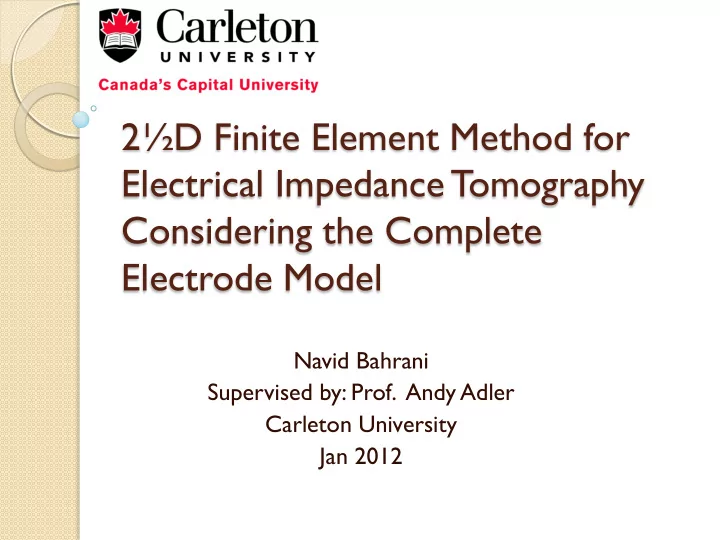

2½D Finite Element Method for Electrical Impedance T omography Considering the Complete Electrode Model Navid Bahrani Supervised by: Prof. Andy Adler Carleton University Jan 2012
Electrical Impedance T omography (EIT) EIT is used to generate images of the internal structure of sections of a body The EIT problem is ◦ to reconstruct an unknown impedance distribution from boundary measurements. Photos: (left) from Wikipedia/EIT, (right) from [4]
The EIT Problem Forward Model (2D & 3D) Finite Element Method Current Patterns Electrode Models
2½D Motivation The 3D FE Model recruits too much elements. ◦ => requires much more memory and Computational Complexity vs. 2D ◦ Both Forward and Inverse Problem ◦ Specially the inverse part ◦ Requires more calculation time ≠ Real time ◦ Or a super-computer for fast imaging ≠ Portability and Inexpensiveness
The 2½D Model Assumption ◦ Translational Invariance along z ◦ => Symmetric Voltages Equations
Boundary Condition for I = 1
Finite Element Method Interpolation functions, i.e. basis The Modified ‘ Stiffness Matrix ’ Image from Wikipedia/Finite Element Method
Inverse Problem of EIT Static EIT, Difference EIT Jacobian (Sensitivity Matrix)
Inverse Problem in 2½D Using Jacobian: ◦ For each
Complete Electrode Model
3D CEM
Mesh 2D mesh with 4096 elements used for the 2½D method (32 layers in xy) 3D mesh with 737,280 elements (61 layers in z) H=2; h=0.1, w ≈ 0.1 The Images are produced by EIDORS
Results for Measurements Measurements (Difference Voltage of Electrodes) – Opposite Pattern - Only first 5 terms Maximum error: 0.82% (0.002)
Comparing 3D, 2D, 2D/H (first term of 2½D) and 2½D CEM solutions for electrode voltages - CEM (W = 0.1, H = 2,h = 0.4)
Decrement of the Error by Decrement of the Element size
Sources of Mismatch 3D Interpolation Function Injected Current Pattern 2D-based Complete Electrode Modelling
Truncation Point
Speed/Computation Improvement
Achievements 2D: 2,113 nodes and 4,094 elements if M = 61 slices 3D: 128,893 nodes and 736,920 elements M 2 = 61 61 = 3,681 M 2 = 61 61 = 3,681
The EIDORS Project http://eidors3d.sourceforge.net/ Electrical Impedance and Diffuse Optical Tomography Reconstruction Software A collaborative project where many groups working on EIT are involved around the world Modular-Based structure Medical & Industrial Applications
Questions ?
Reference [0] Ider et al , Electrical impedance tomography of translationally uniform cylindrical objects with general cross-sectional boundaries . IEEE Trans. Med. Imaging 9 49 – 59, 1990. [1] Lionheart W R B, Uniqueness, shape and dimension in EIT, Ann. NY Acad. Sci. 873 466 – 71, 1999 [2] K Jerbi, W R B Lionheart, et al sensitivity matrix and reconstruction algorithm for EIT assuming axial uniformity, Physiol. Meas. 21 (2000) 61 – 66 [3] David Holder, Electrical impedance tomography: methods, history, and applications , 2004 [4] Costa E.L.V., Lima R. Gonzalez, Amato M.B.P ., “Electrical Impedance Tomography”, Yearbook of Intensive Care and Emergency Medicine, 2009. [6] …
Results
Results of the Forward Model
Max Error with respect to the summation of 40 extra terms H = 0.5, h = 0.75 (h/H = 0.75) H = 0.5, h = 0.05 (h/H = 0.1)
Max Relative Measurement Error (%) with respect to 3D H = 0.5, h = 0.75 (h/H = 0.75) H = 0.5, h = 0.05 (h/H = 0.1)
Decrement of the Error by Decrement of the Element size
Recommend
More recommend